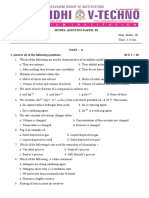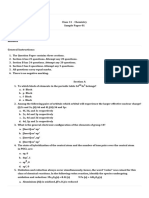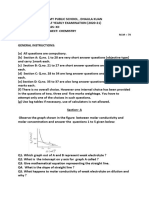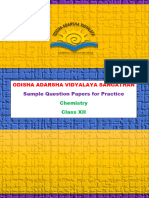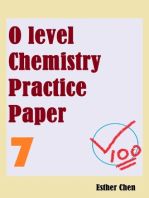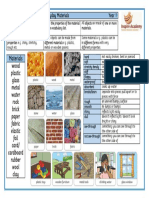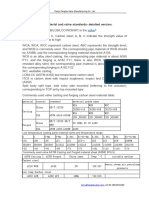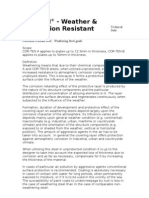CBSE Class 11 Chemistry Sample Paper-05: Material Downloaded From - 1 / 12
CBSE Class 11 Chemistry Sample Paper-05: Material Downloaded From - 1 / 12
Uploaded by
WE ARE CRaZyCopyright:
Available Formats
CBSE Class 11 Chemistry Sample Paper-05: Material Downloaded From - 1 / 12
CBSE Class 11 Chemistry Sample Paper-05: Material Downloaded From - 1 / 12
Uploaded by
WE ARE CRaZyOriginal Description:
Original Title
Copyright
Available Formats
Share this document
Did you find this document useful?
Is this content inappropriate?
Copyright:
Available Formats
CBSE Class 11 Chemistry Sample Paper-05: Material Downloaded From - 1 / 12
CBSE Class 11 Chemistry Sample Paper-05: Material Downloaded From - 1 / 12
Uploaded by
WE ARE CRaZyCopyright:
Available Formats
CBSE
Class 11 chemistry
Sample Paper- 05
Time Allowed: 3Hrs M.M. : 70
General Instructions :
i. All questions are compulsory.
ii. Q. No. 1 to 5 are very short answer type questions and carry one mark each.
iii. Q. No. 6 to 10 are very short answer type questions and carry two marks each.
iv. Q. No. 11 to 22 are short answer type questions and carry three marks each.
v. Q. No. 23 is value based questions carries four marks.
vi. Q. No. 24 to 26 are long answer type questions and carry five marks each.
vii. Use log tables, if necessary, use of calculator is not allowed.
1. Define limiting reagent
2. Write the general electronic configuration of d-block elements?
3. Write vander Waal's equation for n moles of a real gas.
4. What is the state of hybridisation of each carbon atom in C6H6?
5. Predict the sign of the entropy change for the following:
6.
i. Define Pauli’s exclusion principle.
ii. Write electronic configuration of an atom having 2K, 8L, 5M electrons.
Or
The mass of an electron is 9.1 x 10-31 kg. If its kinetic energy is 3.0 x 10-25 J. Calculate
its wavelength. (Given h = 6.626 x 10-34 Js)
7. The concentration of hydrogen ion in a sample of soft dark is 3.8 x 10-3 M. What is its pH
? (log 3.8 = 0.58)
8. What happens when (write equation only):
i. Beryllium carbide reacts with water.
ii. Sodium sulphate solution is added to an aqueous solution of barium nitrate.
Material downloaded from myCBSEguide.com. 1 / 12
9. Propanal and Pentan-3-one are the ozonolysis product of an alkene. What is the
structural formula of the alkene?
10. Write reactions to justify amphoteric nature of aluminium.
11.
a. Write the IUPAC name of the following:
i.
ii.
b. Which isomerism is shown by following pair of compounds:
CH3COOH and HCOOCH3
12. Account for the following:
a. An anion is always bigger than its present atom.
b. Chlorine (Cl) has move negative electron gain enthalpy the fluorine (F).
c. Noble gases have positive electron gain enthalpy.
13. Give the shapes of following covalent molecules using VSEPR theory:
i. PCI5
ii. BrF3
iii. H2O
14. A sample of drinking water was found to be severely contaminated with chloroform
CHCl3, supposed to be carcinogen. The level on contamination was 15 ppm (by mass).
i. Express this in percent by mass.
ii. Determine the molality of chloroform in the water sample.
15.
a. State Hess's law.
b. Use standard enthalpies of formation, calculate the value of for the reaction.
Material downloaded from myCBSEguide.com. 2 / 12
16.
a. The molecular orbital theory to predict why the BE molecule does not exist.
b. Compare the stability of and O2 on the basis of M.O. theory.
17.
a. Calculate the total pressure in a mixture of 8g of oxygen and 4g of hydrogen confined
in a vessel of 1 dm3 at 27°C.
Given R = 0.083 bar dm3 K-1 mol-1
b. Criticial temperature of CO2 and CH4 are 31.1°C and - 81.9°C respectively. Which of
there has stronger intermolecular forces and why?
Or
a. What would be the S.I. units of a quantity PV2T2/n ?
b. Calculate the temperature of 4.0 moles of a gas occupying 5 dm3 at 3.32 bar (R= 0.083
bar dm3 K-1 mol-1)
18.
a. What is the oxidation no. of Cr. in ?
b. Balance the equation: (Acidic medium)
19. Complete the following chemical reactions.
a.
b.
c.
20. Give reason for the following:
a. PbCl4 is a powerful oxidising agent.
b. Graphite acts as a good lubricant.
c. Boron halides don't dimerise like BH3
21.
a. Draw the structure of (i) BeCl2 (vapour) and (ii) BeCl2 solid
b. Complete the equation:
Material downloaded from myCBSEguide.com. 3 / 12
22. Arrange the following in order of property mentioned against each:
a.
(increasing order of stability)
b. HCOOH, CH3COOH, CH3CH2COOH (Increasing acidic strength)
c.
Value Based Questions
23. Environmental pollution is causing a serious threat on the earth. Due to combustion of
fossil fuels, a number of poisonous and harmful gases enter into the atmosphere. Every
country has made strict laws for industries and individual citizens to keeps pollution
under control.
Now answer the following questions:
a. Why is it advised not to sleep with burning coke angithi in a closed room on winter
nights?
b. What does the combustion of motor fuels cause pollution of the atmosphere?
c. Name one natural source and one human activity by which SO2, enters into
atmosphere?
24.
a. Explain the following with example:
i. Common ion effect
ii. Buffer solution.
b. At a certain temperature and total pressure of 105 Pa, iodine vapours contains 40% by
volume of I atoms.
Calculate Kp for the equilibrium.
Material downloaded from myCBSEguide.com. 4 / 12
Or
a. Define Le- Chatelier's principle.
b. Define pH.
c. Equilibrium constant for the reason is 4.0. What will be the equilibrium constant for
the reverse reaction.
d. Calculate the pH of 10-8 M HCl solution.
25.
a. Define Heisenberg's uncertainty principle. Write its mathematical expression.
b. Calculate the uncertainty in the velocity of a cricket ball on mass 150 g. If the
uncertainty in its position is of the order of 1 .
(h = 6.6 x 10-34 Kg m2s-1)
Or
a. Which of the following orbitals are not possible
1p, 2s, 2p, 3S
b. Which of the following sets of quantum number are not possible? Give reasons.
i. n = 0, l = 0, ml = 0, ms = +1/2
ii. n = 1, l = 0, ml = 0, ms = -1/2
c. Electrons are emitted with zero velocity from a metal surface when it is expressed to
radiation of wavelength . Calculate threshold frequency and work
function of the metal.
26.
a. Define the following with example:
i. Wurtz reaction
ii. Markovnikoff’s Rule.
b. Give the main product of the region:
i.
ii.
Material downloaded from myCBSEguide.com. 5 / 12
iii.
Or
a. How can you convert the following:
i. Propan-1-ol to propan-2-ol
ii. Ethyl chloride to n-Butane
b. Complete the following reactions:
i.
ii.
iii.
Answers
1. The reactant which is completely consumed during the reaction is called limiting reagent.
2. (n - 1)d1-10 ns1-2.
3.
4. sp2 hybridisation.
5. -ve, as randomners decrease.
6.
a. No two e- in an atom can have same set of all the four quantum numbers.
b. Total e- = 15
E.C. = 1s2 2s2 2p6 3s2 3p3
Or
Material downloaded from myCBSEguide.com. 6 / 12
pH = -log [H+]
= -log 3.8 = 3 = 3 - 0.58
=2.42
i. Be2C + 4H2O 2Be(OH)2 + CH4
ii. Na2SO4 + Ba(NO3)2 BaSO4 + 2NaNO3
7.
8.
9.
10.
= -12977.57 + 13141.8
, Process is non-spontaneous
11.
a.
i. 4-Nitro benzoi acid
ii. 3-Methyl hexa-1, 5-diene
b. Functional isomerism
12.
a. Because nuclear charge decrease/e- increase.
b. Because of bigger size of chlorine/less e- - e- repulsion as compared to fluorine.
c. Because they have fully filled orbitals.
13.
a. Trigonal bipyramidal.
b. Bent T-shape
c. Bent/V-shape
Material downloaded from myCBSEguide.com. 7 / 12
14.
a. 15 ppm means 15 parts in million (106) parts.a
b. Molar mass of CHCl3 = 119.5 g/mol
100 g of sample contain chloroform =
1000 g of sample contain =
Molality of chloroform =
Molality
15.
a. 2Al(s) + 3H2SO4 (aq) Al2(SO4)3 (aq) + 3H2(g)
b. 2Al(s) + 2NaOH (aq) + 6H2O(l) 2Na+[Al(OH)4]- (aq) + 3H2(g) Sodium tetrahydroxo
aluminate (III)
16.
a. Be:
Bond order =
As bond order of Be2 is zero and does not exist.
b.
Greater the bond order, move will be stability.
17.
a.
Total no of moles = 2+ 0.25 = 2.25 mol
V = 1 dm3, T = 300 K, R = 0.083 bar dm3 K-1 mol-1
PV = nRT
P = 56.025 bar
Material downloaded from myCBSEguide.com. 8 / 12
b. CO2 has stronger intermolecular forces because it can be liquiefied at temperature
upto but CH4 can be liquefied only upto .
18.
a. x = 6
b.
19.
a. PsB + 4H2O2 PbSO4 + 4H2O
b.
c. Ca3N2 + 6H2O Ca(OH)2 + 2NH3
20.
a. Because Pb+4 is reduced to more stable Pb+2.
b. Because of its soft and slippery nature.
c. Boron due its small size cannot four large size chlorine atoms around it and hence
exists as monomer.
21.
a.
i.
ii.
b.
22.
a.
Material downloaded from myCBSEguide.com. 9 / 12
b.
c.
23.
a. On burning coke, a lot of CO is produced which causes anoxia.
b. On burning motal-fuels, toxic oxides of nitrogen is formed which affect respiratory
system.
c. Due to volcanic eruption and through combustion of sulphur containing fuels.
d. Concern for environment
24.
a.
i. It is the shift in an ionic equilibrium caused by the addition of a solute that
provides caused by the addition of a solute that provides an ion that takes part in
the equilibrium.
ii. The solution which resist the change in pH on dilution/addition of acid or alkali.
b. Partial pressure of I atom (PI)
Partial pressure of I2 atom (PI2)
i. Correct statement.
ii. negative logarithm of hydrogen ion concentration.
iii.
iv. 10-8 M HCl
[H+] = 10-8 + 10-7
[ [H+] conc. due to water = 10-7]
Or [H+] = 11 x 10-8 PH = - log[11 x 10-8]
= 8 - 1.02 = 6.98
25.
a. It is impossible to measure simultaneously both the position and velocity of a
microscopic particle with accuracy or certainty.
Material downloaded from myCBSEguide.com. 10 / 12
Mathematically expression
b. Mass of ball m = 150 g
= 150 x 10-3 kg = 0.150 kg
Uncertainty in position
= 3.52 x 10-24 m s-1.
Or
a. 1p as n = l, not possible.
b. (i) n = 0, l = 0, ml = 0, ms = +1/2 not possible because n cannot be zero.
c. Energy of photon
= 2.93 x 10-19 J
Energy of photon = K.E. + W0 = 0 + W0 = W0
W0 = 2.93 x 10-19 J
Threshold frequency
26.
a.
i. It involves the chemical reaction between alkylhalides and metallic sodium in
presence of dry ether and from alkanes.
ii. It states that more electronegative part of the addendum adds to that carbon of
double bond which contains lesser no. of H-atoms.
b.
i.
Material downloaded from myCBSEguide.com. 11 / 12
Or
a.
i. C{H_3}C{H_2}C{H_2}OH\xrightarrow[\Delta ]{{alc.KOH}}C{H_3}CH = C{H_2
ii.
b.
i. CH3CH2CH2BR
ii. CH3 - CH3
iii. CH3-CH=CH-CH3
Material downloaded from myCBSEguide.com. 12 / 12
You might also like
- Tiles BS 5385Document10 pagesTiles BS 5385Kalin83% (6)
- Class 11 ChemistryDocument4 pagesClass 11 ChemistryKamal's chemistryNo ratings yet
- Cbse Question Paper 2019 (Set-1) Class 11 Chemistry Mahanhi Palanjall Vldyamandir, PrayagrajDocument5 pagesCbse Question Paper 2019 (Set-1) Class 11 Chemistry Mahanhi Palanjall Vldyamandir, PrayagrajBibha KumariNo ratings yet
- SCH3U - Practice ExamDocument9 pagesSCH3U - Practice ExamWaqas AhmadNo ratings yet
- CBSE Class 12 Chemistry Sample Paper-15: Material Downloaded From - 1 / 14Document14 pagesCBSE Class 12 Chemistry Sample Paper-15: Material Downloaded From - 1 / 14Allen Neal JonesNo ratings yet
- 11 Chemistry SP 1Document10 pages11 Chemistry SP 1Sarthi GNo ratings yet
- Sy Chemistry Q. Bank Sem 1 2023-24Document7 pagesSy Chemistry Q. Bank Sem 1 2023-24Kia AsherNo ratings yet
- Model Paper-2Document4 pagesModel Paper-2mkrishna collegeNo ratings yet
- 11 Chemistry Sample Paper 01Document16 pages11 Chemistry Sample Paper 01loduuNo ratings yet
- Chemistry 12Document8 pagesChemistry 12dhritibarak548No ratings yet
- 12 Lyp Chemistry s1 PDFDocument7 pages12 Lyp Chemistry s1 PDFBT De0pA PUBG MOBILENo ratings yet
- 12 Chemistry23 24 sp03Document14 pages12 Chemistry23 24 sp03bhattkrrish339No ratings yet
- Final 11 Chemistry (Answersheet)Document11 pagesFinal 11 Chemistry (Answersheet)Kedar GuravNo ratings yet
- OBNPr SWB VCPK XJ QZ CZYBDocument10 pagesOBNPr SWB VCPK XJ QZ CZYBujjawalrajgupta30No ratings yet
- Practice Paper-II Subject: Chemistry (Theory) Class: XI Time: 3 Hrs. M.M.: 70Document5 pagesPractice Paper-II Subject: Chemistry (Theory) Class: XI Time: 3 Hrs. M.M.: 70Uddipta K. SaikiaNo ratings yet
- 12 Chemistry23 24 sp04Document14 pages12 Chemistry23 24 sp04joshiaditi307No ratings yet
- Chemistry Class XI Unsolved Sample Paper 1Document4 pagesChemistry Class XI Unsolved Sample Paper 1s.shaw71101No ratings yet
- Che (Set A) Xi - 3RD Term 80 Final PrintDocument6 pagesChe (Set A) Xi - 3RD Term 80 Final PrintfghughjjguhvjiNo ratings yet
- Chem Set 1Document6 pagesChem Set 1ALOK RANJANNo ratings yet
- 11 Chemistry Solved 05Document4 pages11 Chemistry Solved 05asdfghjklNo ratings yet
- 11 Chemistry23 24sp 01Document13 pages11 Chemistry23 24sp 01AbhishekNo ratings yet
- Chem 12 H.Y (2020-21)Document6 pagesChem 12 H.Y (2020-21)YahooNo ratings yet
- 2nd PU Chemistry Model QP 2Document8 pages2nd PU Chemistry Model QP 2Prasad C M100% (1)
- Question PAPERDocument6 pagesQuestion PAPERharsh.mahori09No ratings yet
- Chemistry SQP 2Document11 pagesChemistry SQP 2ACHAL PATILNo ratings yet
- CLASS XII Chemistry-SQP 22-23Document16 pagesCLASS XII Chemistry-SQP 22-23Yug GandhiNo ratings yet
- Sample PapersDocument65 pagesSample PapersKatara BittuNo ratings yet
- Chemistry SQPDocument11 pagesChemistry SQPSariska MehraNo ratings yet
- 12 Chemistry23 24 sp10Document14 pages12 Chemistry23 24 sp10Babur HussainNo ratings yet
- 11 Sample Papers Chemistry 2020 English Medium Set 4Document5 pages11 Sample Papers Chemistry 2020 English Medium Set 4mehtamanjil1508No ratings yet
- CBSE Sample Paper 2020.pdf202110050830371633422637Document13 pagesCBSE Sample Paper 2020.pdf202110050830371633422637aashishkm321No ratings yet
- 12TH ChemistryDocument11 pages12TH ChemistryAkshatNo ratings yet
- XII Chemistry Sample Question Paper - FinalDocument65 pagesXII Chemistry Sample Question Paper - Finalkrishnapradhani091No ratings yet
- Sample Paper-05 CHEMISTRY (Theory) Class - XI: Material Downloaded From andDocument4 pagesSample Paper-05 CHEMISTRY (Theory) Class - XI: Material Downloaded From andDivyansh Waghmare0% (1)
- 12 Chemistry23 24 sp11Document14 pages12 Chemistry23 24 sp11Babur HussainNo ratings yet
- Chemistry SQP PDFDocument8 pagesChemistry SQP PDFÀĺťhàf AnsariNo ratings yet
- 34 FINAL RemovedDocument48 pages34 FINAL RemovedAkshay C KNo ratings yet
- Chem PreboardDocument13 pagesChem Preboardvirender.pinghalNo ratings yet
- CLASS 12 Chem Practice Sample QP CHEM SET 1Document20 pagesCLASS 12 Chem Practice Sample QP CHEM SET 1Minecraft NoobsNo ratings yet
- Chemistry Set 1Document7 pagesChemistry Set 1krish.meghashriNo ratings yet
- T3 Hs Ob MJVN DY4 Ru 2 NSIcDocument23 pagesT3 Hs Ob MJVN DY4 Ru 2 NSIcYashveer RaiNo ratings yet
- Answer Key - Chemistry - Diagnostic ExamDocument2 pagesAnswer Key - Chemistry - Diagnostic ExamNiño Edrianne Nimo100% (2)
- Mte XiiDocument5 pagesMte Xiipreetijain29824No ratings yet
- Chemistry SQP PDFDocument14 pagesChemistry SQP PDFArohi SinghNo ratings yet
- QN BanksDocument4 pagesQN BankssaniamurshidaNo ratings yet
- II Puc Mid - Term Exam Model Question Paper (2024 - 25)Document4 pagesII Puc Mid - Term Exam Model Question Paper (2024 - 25)rajsilver110No ratings yet
- Chemistry Test - 12th Science-ChemistryDocument7 pagesChemistry Test - 12th Science-ChemistryAishley ChalametNo ratings yet
- Chem. Model OneDocument11 pagesChem. Model OneNimonaNo ratings yet
- Sample Paper +2 Chemistry 18.01.23Document3 pagesSample Paper +2 Chemistry 18.01.23Raj Online ServicesNo ratings yet
- Inorganic Chemistry Problem SetsDocument6 pagesInorganic Chemistry Problem Setsarejay castroNo ratings yet
- Hydrocarbon 1Document6 pagesHydrocarbon 1VK CREATIONNo ratings yet
- CBSE Sample Question Papers For Class 12 Chemistry 2020Document16 pagesCBSE Sample Question Papers For Class 12 Chemistry 2020Emtiaz AnsariNo ratings yet
- Half Yearly Exam Paper 1Document7 pagesHalf Yearly Exam Paper 1AëNo ratings yet
- Ii Pu Model QP 1Document4 pagesIi Pu Model QP 1mkrishna collegeNo ratings yet
- Chemsitry 09.12.2022Document4 pagesChemsitry 09.12.2022santhosNo ratings yet
- Chemistry QP - PB XiiDocument5 pagesChemistry QP - PB XiiSnehaNo ratings yet
- Class11 SEQP Chem 22-23 PDFDocument13 pagesClass11 SEQP Chem 22-23 PDFTanishq SinghNo ratings yet
- Practice Makes Perfect in Chemistry: Oxidation-ReductionFrom EverandPractice Makes Perfect in Chemistry: Oxidation-ReductionRating: 5 out of 5 stars5/5 (1)
- Pathology QPDocument25 pagesPathology QPWE ARE CRaZyNo ratings yet
- New Merge Doc 2023-01-07 083427 - 4Document59 pagesNew Merge Doc 2023-01-07 083427 - 4WE ARE CRaZyNo ratings yet
- Spotters MicroDocument27 pagesSpotters MicroWE ARE CRaZyNo ratings yet
- Pharmacology QPDocument17 pagesPharmacology QPWE ARE CRaZyNo ratings yet
- Study Material: Downloaded From VedantuDocument15 pagesStudy Material: Downloaded From VedantuWE ARE CRaZyNo ratings yet
- 05-SENSORY ORGANS TheoryDocument19 pages05-SENSORY ORGANS TheoryWE ARE CRaZyNo ratings yet
- CBSE Class 11 Chemistry Sample Paper-05: Material Downloaded From - 1 / 12Document12 pagesCBSE Class 11 Chemistry Sample Paper-05: Material Downloaded From - 1 / 12WE ARE CRaZyNo ratings yet
- EnglishDocument1 pageEnglishWE ARE CRaZyNo ratings yet
- 12 English CH 07 Evans Tries An PDFDocument3 pages12 English CH 07 Evans Tries An PDFWE ARE CRaZyNo ratings yet
- Koc Standard FOR Colour Coding of Pipes and Fittings For Material Identification Doc No: Koc-Mp-026Document14 pagesKoc Standard FOR Colour Coding of Pipes and Fittings For Material Identification Doc No: Koc-Mp-026Praveen BabuNo ratings yet
- 10200431-10200363-10200041-Poly PlastDocument2 pages10200431-10200363-10200041-Poly PlastkasvikrajNo ratings yet
- BORED Pile and Pile Cap DesignDocument51 pagesBORED Pile and Pile Cap DesignRahman PrasojoNo ratings yet
- 0810 Civil CEC801 DDRCS SAMPLEQBDocument12 pages0810 Civil CEC801 DDRCS SAMPLEQBNabeel KarvinkarNo ratings yet
- ShaftDocument6 pagesShaftAdiNo ratings yet
- Yr 1 SCIENCE Everday MaterialsDocument1 pageYr 1 SCIENCE Everday MaterialsChimera EarthaNo ratings yet
- Theories of Elastic FailureDocument15 pagesTheories of Elastic FailurejaishowNo ratings yet
- Radiation Damage of MaterialDocument26 pagesRadiation Damage of Materialdominique sabujNo ratings yet
- Energy Balance Energy Balance On Saw Dust DigesterDocument12 pagesEnergy Balance Energy Balance On Saw Dust DigesterMae Florizel FalculanNo ratings yet
- Coating QaDocument17 pagesCoating Qasbmmla100% (9)
- YORK Solution Semi-Custom Air Handler Sales Brochure, PUBL-2286Document8 pagesYORK Solution Semi-Custom Air Handler Sales Brochure, PUBL-2286Norman Joe MendozaNo ratings yet
- Design and Fabrication of Three-Dimensional Polymer Optical Waveguide-Based Fan-In/out Device For Multicore FibersDocument3 pagesDesign and Fabrication of Three-Dimensional Polymer Optical Waveguide-Based Fan-In/out Device For Multicore FibersJ MrNo ratings yet
- Components of A Fibre CableDocument7 pagesComponents of A Fibre Cableonesimomanuel7No ratings yet
- Oasis PergolaDocument52 pagesOasis PergolaChris JonesNo ratings yet
- Lead Alloys For Permanent Anodes inDocument4 pagesLead Alloys For Permanent Anodes inReda TammamNo ratings yet
- Daring - 11138868soal PTS 4 Bahasa Inggris Kelas XI WAJIB 2022Document19 pagesDaring - 11138868soal PTS 4 Bahasa Inggris Kelas XI WAJIB 2022Farhan Bintang SetiawanNo ratings yet
- Nordel Ip 3640Document2 pagesNordel Ip 3640Arun KumarNo ratings yet
- Chapter 2 - TTA - TTT - DiagramsDocument13 pagesChapter 2 - TTA - TTT - DiagramsPrasad Mhatre100% (1)
- Valve Material and Valve Standards Detailed VersionDocument21 pagesValve Material and Valve Standards Detailed VersionMuhammed Ali PisuwalaNo ratings yet
- Answer For Problem Exercise: 1. Conceptual QuestionDocument2 pagesAnswer For Problem Exercise: 1. Conceptual Questionstill jungkookNo ratings yet
- Sem IDocument38 pagesSem Iomenlopes6No ratings yet
- STPM 2019 Sem 2uDocument7 pagesSTPM 2019 Sem 2uAprillia ChanNo ratings yet
- 5a. Solid WasteDocument38 pages5a. Solid WasteAthirah DinataNo ratings yet
- Cor-Ten - Weather & Corrosion Resistant SteelDocument5 pagesCor-Ten - Weather & Corrosion Resistant SteelAnjan DeyNo ratings yet
- CHAPTER 4 - LATERAL EARTH PRESSURE (R) PDFDocument27 pagesCHAPTER 4 - LATERAL EARTH PRESSURE (R) PDFRoopen FearkyNo ratings yet
- Copolymers Are Polymers Composed of Two orDocument1 pageCopolymers Are Polymers Composed of Two orMatti NoNo ratings yet
- The Thermal Behaviour 0F Overhead ConductorsDocument14 pagesThe Thermal Behaviour 0F Overhead ConductorsjuanperezpintoNo ratings yet
- Interpretation of Liquid Penetrant Indications: HapterDocument35 pagesInterpretation of Liquid Penetrant Indications: Hapteradilshahzad2001No ratings yet
- Review REDocument13 pagesReview REMENo ratings yet







